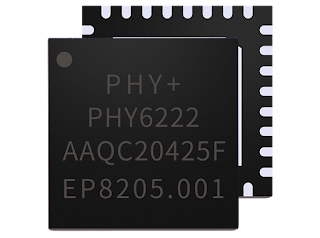PHY622X BLE SoC from PHYPLUS

About PHYPLUS PHY622X BLE SoC is manufactured by PHYPLUS Shanghai, a leading advanced BLE SoC supplier in China. Key Features for PHY6222 Cortex-M0 with SWD (only for debug) 128KB-8MB flash memory 64KB SRAM, retention in sleep mode 4-way instruction cache with 8KB cache RAM 96KB ROM (BLE/BLE Mesh stack) 256bit efuse 22 GPIOs GPIO retention in off/sleep mode IO MUX function mapping All pins can be configured for wake-up All pins for triggering interrupt 3x QDEC 6x PWM 2x PDM/I2C/SPI/UART 4x DMA 8x 12bit ADC with low noise voice PGA 6x 24bit timer, one watchdog timer RTC (w/o calendar) Operating range: 1.8 to 3.6V Embdeed buck DC/DC and LDOs battery monitor RC oscillator hardware calibrations Support BLE 2Mbps protocol Support Data Length Extension Throughput up to 1.6Mbps BLE 5.1 Support SIG-Mesh Multi-Feature 2.4GHz transceiver -103dBm @ BLE 125Kbps TX power -20 to _10dBm in 3dB steps AES-128 encryption Link layer hardware Operation temperatrue: -40 to 125 degree RoHS package: QFN32 Re




